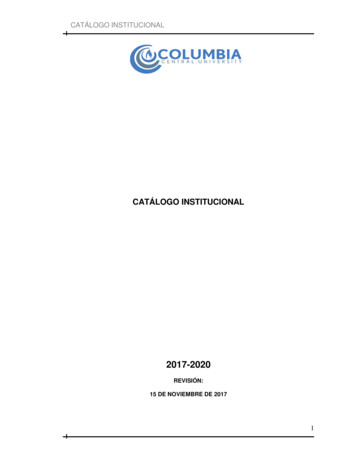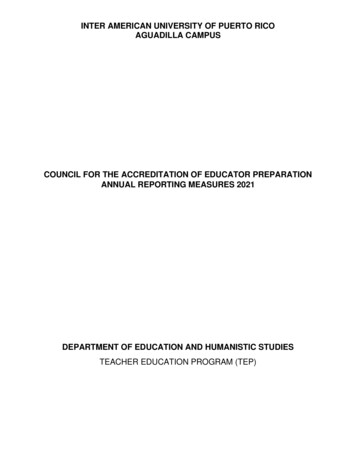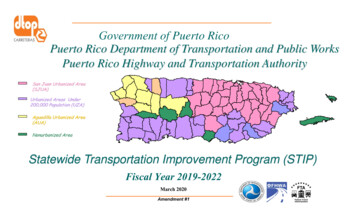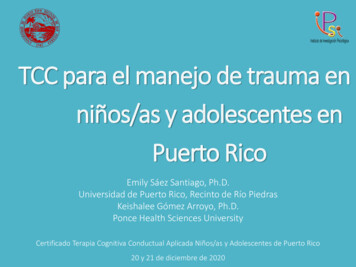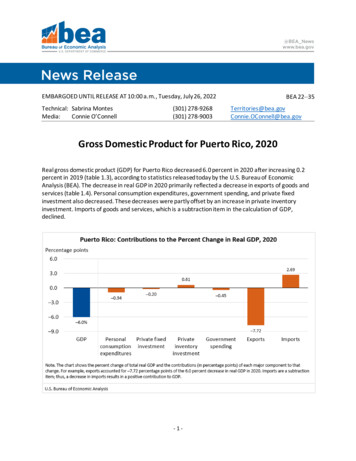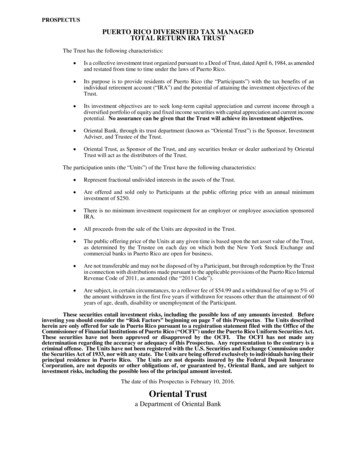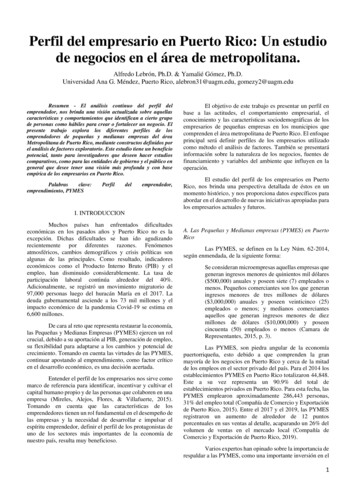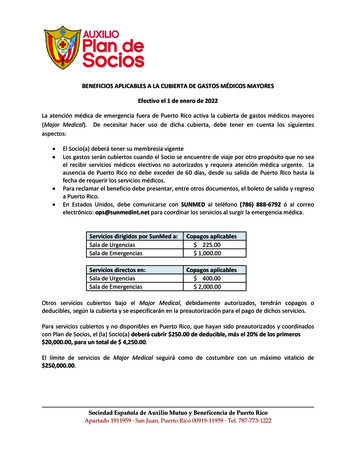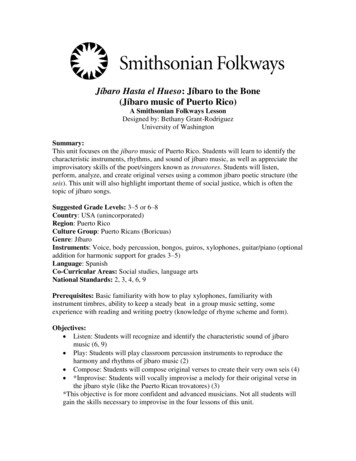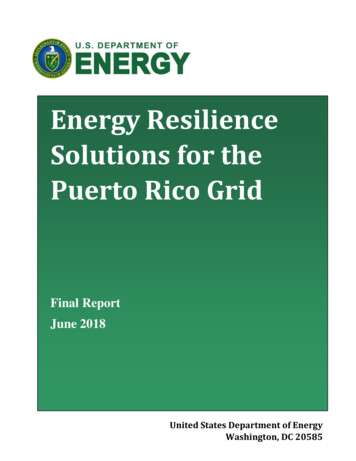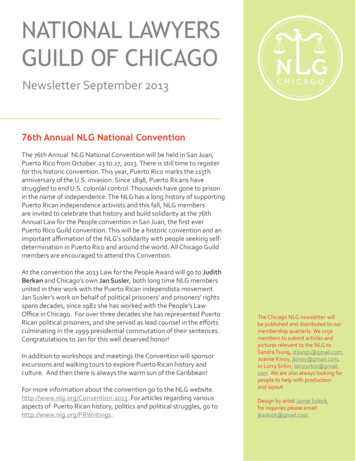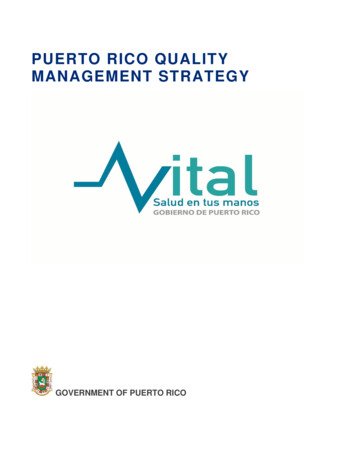
Transcription
PUERTO RICO QUALITYMANAGEMENT STRATEGYGOVERNMENT OF PUERTO RICO
PUERTO RICO QUALITY M ANAGEMENT STRATEGYGOVERNMENT OF PUERTO RICOCONTENTS1. Introduction . 1 Overview . 1 Historical Background . 1 Membership . 32. Quality Program . 5 Quality Strategy Purpose, Goals and Objectives . 5 Special Health Care Needs . 9 Quality Management Strategy Feedback Process . 103. Puerto Rico Standards . 15 Provider Network Access Standards . 15 Measurement and Improvement Standards . 174. Conclusions and Opportunities . 24Appendix A: QMS Crosswalk . 25i
PUERTO RICO QUALITY M ANAGEMENT STRATEGYGOVERNMENT OF PUERTO RICO1INTRODUCTIONOVERVIEWThe Puerto Rico Medicaid Quality Management Strategy (QMS) provides the guidance to advanceisland-wide quality improvement through a focus on performance improvement (PI) by providingquality services that are patient-centered and aimed at increasing the use of preventive care andappropriate delivery of care in a timely manner. The QMS has been revised in accordance with theCode of Federal Regulation (CFR) at 42 CFR 438.340. This is the fourth revision of the QualityStrategy which was first developed in 2006. This document includes the elements of the QMSrequired by the Centers for Medicare & Medicaid Services (CMS), but also includes Puerto Ricospecific quality goals and measures. The Government of Puerto Rico (“the Government” or “PuertoRico”) has delegated the managed care system to the Puerto Rico Health Insurance Administration(PRHIA) (known in Spanish with its acronym as the Administración de Seguros de Salud (“ASES”)de Puerto Rico).In order to demonstrate compliance with the CMS Quality Strategy requirements set forth in42 CFR 438.340, Puerto Rico prepared an analysis that identifies each required element of theQMS and where it has been addressed in the QMS (Appendix A). Puerto Rico will use this analysisas one of our many tools in our toolkit to evaluate the effectiveness of the QMS on improving theperformance of our managed care partners and improving the quality of care.HISTORICAL BACKGROUNDASES has the responsibility to implement, administer, and negotiate through contractualarrangements those healthcare services included in the Puerto Rico Government Health Plan(GHP), which is also known as Plan Vital (both terms are used interchangeably in this document).The contracting of such services will be through those managed care organizations (MCOs)authorized by Federal and Puerto Rico law that will provide risk management as required underTitles XIX and XXI of the Social Security Act, as well under provisions in 42 CFR Part 438 and StateLaw 72 of September 7, 1993, as amended. Through these MCOs, the GHP provides a healthinsurance system that furnishes access covered services to Puerto Rico’s Medicaid population.The QMS is designed to provide the framework to advance the GHP’s focus on PI activities by:building a culture that is focused on outcomes, efficiently deploying resources, setting realistic andattainable goals, and providing a pathway of progressive discipline to hold managed carecontractors responsible and accountable. Because GHP offers an integrated benefit package whichincludes physical health (PH) and behavioral health (BH) services, we have found each componentplays a critical part in the development of the QMS.1
PUERTO RICO QUALITY M ANAGEMENT STRATEGYGOVERNMENT OF PUERTO RICOThe Government of Puerto Rico’s public policy states that the government has an inherentresponsibility to furnish health care services to the Medicaid population. The public policy delineatesthe duties and responsibilities of the Government of Puerto Rico through its agent, ASES, tofacilitate and manage the following: (1) negotiation; (2) contracting; and (3) monitoring by means ofa managed care organization, which includes the quality of healthcare services. ASES maintains theauthority and responsibility for the updating and annual evaluation of the QMS and that it is updatedas needed based on performance, feedback from stakeholders, and/or changes in policy resultingfrom legislative, Puerto Rico, or Federal requirements.In 2015, the GHP implemented a new service model with objectives to transform Puerto Rico'shealth system that promotes an integrated approach to PH and BH and improves access to qualityprimary and specialty care services. The GHP Colocation and Reverse Colocation integrated modelprovides a health care delivery framework to improve access to care in an integrated and holisticmanner. The MCOs facilitated the placement of a psychologist or other type of BH Provider in eachPrimary Medical Group (PMG) setting. In the scenario of Reverse Colocation, PH services areavailable to Enrollees being treated in BH settings.On November 1, 2018, ASES expanded the regional delivery system to an island-wide model withchoice of MCO under the Plan Vital program. In this model, enrollees are provided choicecounseling and select an MCO that best meets their needs and desires. The island-wide approachfacilitates access around the island and allows the MCOs to establish a wide network of Providers.The enrollees who were previously assigned to the virtual region (foster children and domesticviolence victims) continue to be assigned to one MCO. In addition, the MCOs are responsible forensuring continued care and provider access for enrollees transitioning between MCOs inaccordance with section 5.5 of the contract and 42 CFR 438.62.ASES provides the rules and focus on the performance it wants to achieve in order to maximize theresources without limiting access, timeliness, and quality of health care and is committed to defineand design improvement projects focused on clinical and non-clinical aspects and access toservices, which may prevent future health conditions and promote health among the GHP Enrollees.Plan Vital includes the Health Care Improvement Program (HCIP), which consists of four initiativessubject to performance indicators and a retention fund on the MCOs specified in the HCIP Manualwhich is found at Attachment 19 of the Contract. The HCIP program replaces Disease Managementand other less effective elements and holds the MCOs financially responsible for meeting prescribedoutcome measures.The four initiatives are as follows: Healthy People InitiativeHigh Cost Conditions InitiativeChronic Conditions InitiativeEmergency Room High Utilizers Initiative2
PUERTO RICO QUALITY M ANAGEMENT STRATEGYGOVERNMENT OF PUERTO RICOThe QMS provides the oversight and guidance to assess the needs and areas of improving theaccess, timeliness, and quality of health care of our Enrollees through PI projects, performancemeasures (such as Health Care Effectiveness Data and Information Set (HEDIS), ConsumerAssessment of Healthcare Providers and Systems (CAHPS), Health Outcomes Survey (HOS),HCIP, etc.), as well as monitoring of the contractual compliance standards. In addition, Puerto Ricohas developed an enhanced Care Management (CM) Program that has been modified to improvethe health outcomes of the Medicaid population and devote greater resources and interventions tothe medically complex by identifying high-cost/high-need (HCHN) populations and to close any gapsbetween the enrollee’s health care and the responsibility and role of providers treating that enrollee.MEMBERSHIPPuerto Rico has sole authority to determine eligibility for GHP, as provided in Federal law andPuerto Rico's State Plan, with respect to the Medicaid and CHIP eligibility groups. The island has adiverse geography covering 78 municipalities, which includes a mix of urban/semi-urban, suburbanand rural areas. Figure #1 below outlines the municipalities throughout the island:3
PUERTO RICO QUALITY M ANAGEMENT STRATEGYGOVERNMENT OF PUERTO RICOThe total population insured under GHP is 1,261,588 enrollees as of June 2018. The followingcharts illustrate the insured population by eligible category, gender and age:11.1%6.8%82.1%MEDICAIDCHIPSTATE201875 70 - 7465 - 6960 - 6455 - 5950 - 5445 - 4940 - 4435 - 3930 - 3425 - 2920 - 2415 - 1910 - 145-91-4 1-60,000-40,000-20,000020,000M40,00060,00080,000F4
PUERTO RICO QUALITY M ANAGEMENT STRATEGYGOVERNMENT OF PUERTO RICO2QUALITY PROGRAMQUALITY STRATEGY PURPOSE, GOALS AND OBJECTIVESThe QMS revision is based on Puerto Rico’s goal to provide patient-centered quality services aimedat increasing the use of screening, prevention, and appropriate delivery of care in a timely mannerto all Medicaid, CHIP and Medicare/Medicaid Dual Eligible enrollees through MCOs operatingisland-wide. The QMS provides a framework to communicate Puerto Rico’s vision of performancedriven objectives and monitoring strategies that address quality of care and timely access toservices. It is a comprehensive approach that drives quality through assessment, initiatives,monitoring and outcome-based PI.The specific goals and objectives that play a significant role in the development of Puerto Rico’sQuality Management Strategy are:#1 Goal: Improve preventive care screening, access of care and utilization of healthservices for all GHP enrollees. Objective: Increase the utilization of preventive care screening services, access ofcare and utilization of health services annually.#2 Goal: Improve quality of care and health services provided to all GHP enrolleesthrough the HCHN program. Objective: Increase the number of initiatives to improve the health of all GHPenrollees with a high-cost condition and chronic condition annually.#3 Goal: Improve enrollee satisfaction with provided services and primary careexperience. Objective: Reach the average score established by the Agency for HealthcareResearch and Quality in the categories of composite items on personal doctor, allhealth care and MCO.ASES recognizes that effective quality improvement must be methodical, ongoing and measureable.For the QMS, a mix of quantitative and qualitative measures have been identified to monitor clinicalquality, access and utilization management (UM) for the program. Puerto Rico prefers to usenationally recognized measure sets whenever possible, including the National Committee for QualityAssurance (NCQA) HEDIS and the Medicaid Adult and Child Core Measurement Sets. Several toolshave been developed to facilitate the implementation of the QMS. The HCIP is one of the toolsdeveloped by ASES to reach this goal. The HCIP Manual ties financial incentives for MCOs toimprove the quality of the program. ASES created quality measures and scored quality measuresfor the MCOs to track and report quarterly; these measures are listed below. The MCOs must5
PUERTO RICO QUALITY M ANAGEMENT STRATEGYGOVERNMENT OF PUERTO RICOdevelop initiatives to improve the health of the population for each scored measure for the healthconditions identified in the HCIP. A second tool used is the reporting and review of annual HEDISmeasures. In addition to the HCIP and HEDIS performance measures, the MCOs will submitenrollee and provider satisfaction survey data and analysis at least annually using CAHPS and theExperience of Care and Health Outcomes (ECHO) survey instruments.MEETING GOALS AND OBJECTIVESASES’s focus is to provide quality services that are patient-centered, promote integration of PH andBH services, and increase the use of screening, prevention and appropriate delivery of care in atimely manner to all Medicaid, CHIP and Medicare/Medicaid Dual Eligible enrollees. ASES hascontracted with MCOs to partner and deliver on the quality goals and objectives. The goals andobjectives address, and are sensitive to, the special needs populations as well as those that qualifyfor HCHNs and outline the requirements in terms of services, deliverables, performance measuresand health outcomes within the contract. Regular and consistent review of the QMS will highlightprogress toward goals and measures and related MCO progress. The outcome findings willdemonstrate areas of compliance and non-compliance with Federal standards and contractrequirements. This systematic review will advance trending year-over-year to engage contractors incontinuous monitoring and improvement activities that ultimately impact the quality of services andreinforce positive change.The strategies and interventions addressed in this QMS are focused on the health promotion,prevention and improving the quality of life, care and services as referenced in Attachment 19 of thecontract. The specific quality and scored measures required for each initiative are defined in detailwithin the HCIP Manual. The MCOs must develop initiatives to improve the health of the populationfor each health condition identified through the indicators listed in the manual.1. Healthy People Initiative: The Healthy People Initiative focuses on preventive screening for allenrollees, including populations identified with high-cost or chronic conditions. The scoredmeasure point distribution for the Healthy People Initiative is a total of 10 points.2. High Cost Conditions Initiative: The High Cost Conditions Initiative focuses on thoseenrollees with a high-cost condition that may be part of the HCHN Program specified inSection 7.8.3 of the Contract. The MCOs are to propose and demonstrate cost saving initiatives,programs, and value-based payment models for provider reimbursement to address HCHNenrollees. The scored measure point distribution for the High Cost Conditions Initiative is a totalof 11 points.3. Chronic Conditions Initiative: The Chronic Conditions Initiative focuses on those enrolleeswith a chronic condition. Chronic conditions are often complex, generally long-term andpersistent, and can lead to a gradual deterioration of health. The MCOs shall include in thequality plan, the use of best practices for care to improve the health of those with a chroniccondition.4. Emergency Room High Utilizers Initiative: The Emergency Room High Utilizers Initiative isdesigned to identify high users of emergency services (including BH) for non-emergencysituations and to allow for early interventions to ensure appropriate utilization of services and6
PUERTO RICO QUALITY M ANAGEMENT STRATEGYGOVERNMENT OF PUERTO RICOresources. The MCO will submit to ASES for approval, a work plan with detailed activities andinterventions aimed at emergency room high utilizers.Additional strategies developed by ASES to achieve goals and objectives, and established in thequality strategies are: Developing and maintaining collaborative agreements among public agency stakeholders toimprove health education and health outcomes as well as manage vulnerable and at-riskenrollees.Improve health information technology (HIT) to ensure that information retrieval and reportingare timely, accurate and complete.Improving the health of enrollees through the identification of social determinants of health andhealth disparities.A method of monitoring, analyzing, evaluating and improving the delivery, quality andappropriateness of health care furnished to all enrollees (including over, under and inappropriateutilization of services) and including those with special health care needs.PROGRAM POPULATIONSASES, through a data-driven approach, analyzes claims/encounter data and the External QualityReview (EQR) report on an annual basis with the purpose to identify and incorporate qualityimprovement strategies on conditions prevalent in the GHP Enrollees. The membership data that isstratified is used to identify specific social aspects that are critical to developing appropriateinterventions. Age, race, ethnicity, gender, and preferred language are examples of thedemographic data included when stratifying enrollees. The data analysis process provides theopportunity to study strategies and interventions for the prevention of the most prevalent conditions.Reviewing claims from 2017, 22.3% of the enrollees meet the definition as high-cost or chronicconditions accounting for 48.1% of the total health cost. The conditions identified within high-costconditions include cancer, end stage renal disease, rheumatoid arthritis, diabetes, asthma,hypertension and chronic obstructive pulmonary disease as the chronic conditions. The currentprogram allows for greater resources, efforts and interventions be devoted to the need and toimplement integrated care programs for people with high-cost conditions, high-need andsocioeconomic factors based on morbidity, use of services and HCHN.7
PUERTO RICO QUALITY M ANAGEMENT STRATEGYGOVERNMENT OF PUERTO RICOTOTAL BENEFICIARIES BY CATEGORY22.3% of High Cost Conditionsand Chronic Conditions4.9% 2.8%19.5%0.9%0.4%71.6%High Cost ConditionsChronic ConditionsPregnant WomenHIVHealthy MembersMEDICARE (A/AB)8
PUERTO RICO QUALITY M ANAGEMENT STRATEGYGOVERNMENT OF PUERTO RICOCOST DISTRIBUTION48% of High CostConditions andChronic Conditions8.0%20.1%38.3%27.9%4.7%0.9%High Cost ConditionsChronic ConditionsPregnant WomenHIVHealthy MembersMEDICARE (A/AB)SPECIAL HEALTH CARE NEEDSSpecial health care needs are defined as any physical, developmental, mental, behavioral,cognitive, or emotional impairment or limiting condition that requires medical management, healthcare intervention, and/or use of specialized services or programs. In accordance with FederalRegulation 42 CFR 438.340(b)(9), ASES has established a Special Coverage benefit designed toprovide services for enrollees with special health care needs caused by serious illness. Therequirements of the Special Coverage benefit are in section 7.7 and Attachment 7 of the contract.MCOs monitor and routinely update a treatment plan for each enrollee who is registered for SpecialCoverage. The treatment plan shall be developed by the Enrollee's Primary Care Provider (PCP),with the enrollee's participation, and in consultation with any specialists caring for the enrollee.MCOs require, in its Provider Contracts with PCPs, that Special Coverage treatment plans besubmitted to the MCO for review and approval in a timely manner. A list of conditions considered inSpecial Coverage is included in Appendix A.9
PUERTO RICO QUALITY M ANAGEMENT STRATEGYGOVERNMENT OF PUERTO RICOHigh-Cost/High-Needs EnrolleesHCHN enrollees are identified as enrollees with a specific set of conditions that require additionalmanagement due to the cost or elevated needs associated with the condition as defined withinAttachment 25 and 7.8.3 of the contract. HCHN enrollees are to be offered CM with the objective toemphasize prevention, continuity of care and coordination of care, including between settings ofcare and appropriate discharge planning for short- and long-term hospital and institutional stays. CMwill advocate for, and link enrollees to, services as necessary across providers, including communityand social support providers, and settings. The specific performance measures associated with theHCHN program are detailed within the HCIP Manual, Attachment 19 of the Contract.High-Utilizer ProgramThe High-Utilizer Program is designed to identify and intervene for enrollees identified with patternsof high utilization as described in Attachment 25. Reporting metrics are described within Attachment16 of the Contract.QUALITY MANAGEMENT STRATEGY FEEDBACK PROCESSThe QMS is designed to ensure that services provided to enrollees meet or exceed establishedstandards for access to care, clinical quality of care and quality of service. In accordance with 42CFR 438.340(c)(2), the QMS will be reviewed and updated no less than once every three years.ASES will achieve this ongoing review and evaluation through reporting, oversight and monitoring ofthe MCOs and through its External Quality Review Organization (EQRO). ASES will also submit arevised QMS at any point if there is a significant change as a result of the ongoing review andevaluation. A significant change will encompass major program changes (i.e., new/change inservices, new/change in populations) or a change in any of the program goals. The public inputprocess described in further detail below will be utilized for any resubmission of the QMS to CMS.In accordance with 42 CFR 438.340(c)(1), GHP enrollees, the general public, and stakeholders willhave the opportunity to provide input and recommendations regarding the content and direction ofthe QMS. The QMS is posted on the ASES website for a two-week period to receive publicfeedback via mail, email and telephonic feedback. A final QMS approved by CMS will be posted tothe ASES website once any edits or changes are incorporated from the feedback received. ASESwill continue to seek participant and family/guardian, stakeholder, and public input into the reviewand evaluation of the QMS on an ongoing basis. This is achieved through the Advisory Boarddelegated to the MCOs in accordance with Section 12.1.8 of the Contract, as well as enrollee andprovider satisfaction surveys, enrollee grievances and appeals, and public forums for the GHPprogram. ASES will incorporate recommendations from enrollees, the general public, MCOs, theEQRO and other stakeholders in setting new goals and revising the QMS as an ongoing process.ASES has contractual requirements in place for ensuring MCOs’ compliance with the structure andoperational standards of 42 CFR 438, Subpart D. ASES evaluates the effectiveness of the QMSthrough ongoing monitoring efforts and oversight of the MCOs. CMS requires the QMS be reviewedand updated no less than once every three years per 42 CFR 438.340(c)(2). ASES will submit arevised QMS at any point there is a significant change as a result of ongoing review and evaluation.10
PUERTO RICO QUALITY M ANAGEMENT STRATEGYGOVERNMENT OF PUERTO RICOA significant change will encompass major program changes (i.e., new services, new populations)or a change in any of the program goals. Public input is important to the process; participantfeedback will be obtained through the MCO Advisory Committee, as well as member and providersatisfaction surveys and member grievances and appeals. This final draft of the QMS, as well as theevaluation of the effectiveness of the previous QMS is currently posted for a two-week period toreceive public input for incorporation into the QMS.11
PUERTO RICO QUALITY M ANAGEMENT STRATEGYGOVERNMENT OF PUERTO RICO3STANDARDS, GUIDELINES AND DEFINITIONSQUALITY AND APPROPRIATENESS OF CAREASES monitors how well the MCOs are complying with contractual standards consistent with 42CFR 438.340(c)(i) through the following mechanisms: QAPI ProgramPuerto Rico-specific data collection and monitoring, and MCO reportingEQRO reportsCMS 416 reportHCIPAll GHP contracts include quality provisions as well as requirements for quality measurement,quality improvement and reporting. ASES receives monthly, quarterly and annual reportsubmissions from the MCOs and evaluates whether the MCO has satisfactorily met contractrequirements. Another major source of information through which ASES assess quality of care isthrough the requirement of a QAPI. The QAPI Program is aimed to increase the health outcomes ofGHP enrollees through the provision of health services that are consistent and compliant withnational guidelines, and NCQA HEDIS standards. The MCOs QAPI Program is submitted to theASES for review and approval.The required list of reporting measures is included in Attachment 16 of the Contract, the Plan VitalReporting Guide and Attachment 19 of the contract (HCIP Manual). At least annually, ASES willidentify and publish selected performance measures.CULTURAL COMPETENCYThe Puerto Rico Medicaid Program obtains race, ethnicity, and primary language from theenrollment form completed by the recipient and provides this information to its MCOs at the time ofenrollment. In addition, ASES requires that all MCOs have a Cultural Competency Plan in place.This plan must describe how the providers, individuals and systems within the MCO will effectivelyprovide services to people of all cultures, races, ethnic backgrounds and religions in a manner thatrecognizes values, affirms and respects the worth and dignity of enrollees. MCOs will serveenrollees in accordance with 42 CFR 438.340(b)(6) and will not discriminate against, or use anypolicy or practice that has the effect of discriminating against, an individual on the basis of (i) healthstatus or need for services or (ii) race, color, national origin, ancestry, spousal affiliation, sexualorientation and/or gender identity.ASES SELECTED HEDIS MEASURESASES collects and reviews a substantial proportion of the CMS adult and child core performancemeasures. As part of the quality assessment process and in compliance with12
PUERTO RICO QUALITY M ANAGEMENT STRATEGYGOVERNMENT OF PUERTO RICO42 CFR 438.340(b)(3)(i), ASES requires that all MCOs report on a specific set of HEDIS measuresas selected and communicated by ASES for each calendar year.CLINICAL PRACTICE GUIDELINESThe MCOs shall adopt clinical practice guidelines (CPGs) in accordance with the criteria in 42 CFR438.236 and 10.2.2.9 of the contract. CPGs shall provide evidenced-based care guidance forclinical decision making, enrollee education and coverage of service determinations, and allow forconsistency and inter-rater reliability. CPGs shall be disseminated to all affected providers, andupon request, to enrollees and potential enrollees.MEMBER SATISFACTIONQuality Surveys are required for assessing and monitoring the quality, appropriateness of care andservices furnished to GHP enrollees. MCOs are required to perform a CAHPS satisfaction surveyfor PH and an ECHO survey for BH, in accordance with Section 12.7.1 of the contract. Both surveyscover topics that are important to enrollees and focus on aspects of quality that enrollees are bestqualified to assess, such as the communication skills of providers and ease of access to health careservices. MCOs shall have a process for notifying providers and enrollees about the availability ofsurvey findings and making survey findings available upon request. MCOs are required to use theresults of the CAHPS and ECHO surveys for monitoring service delivery and quality of services, andfor making program enhancements.MONITORING AND COMPLIANCEAs part of the monitoring and in conformance with 42 CFR 438.206, 438.207, 438.208, 438.210, allMCOs submit utilization statistical reports to ASES. ASES requires all reports as outlined withinAttachment 16 and the Plan Vital Reporting Guide, with data to be submitted according tospecifications determined in Article 18 of the Contract and following the reporting requirements asdescribed in detail through the reporting guide provided.EXTERNAL QUALITY REVIEWTo ensure the accuracy and validity of the data submitted and in compliance with 42 CFR 438.350and 438.358, ASES contracts with an EQRO to conduct annual, independent reviews of the QMS.This includes the review of quality outcomes, timeliness of, and access to, the services coveredunder the GHP and validation of performance measures and PI projects. To facilitate this process,the MCOs supply data, including but not limited to claims data and medical records, to the EQRO.The EQRO’s Scope of Work includes all CMS mandated EQRO protocols and includes thefollowing:1. Performance Improvement Projects (PIPs) as required under 42 CFR 438.340(b)(3)(ii). TheMCOs shall conduct PIPs in accordance with ASES and, as applicable, Federal protocols. ThePIPs will be developed, implemented and maintained following the protocols outlined in Section12.3 of the contract. At a minimum, the topics of the PIPs are:A. One clinical care project in the area of increasing fistula use for Enrollees at-risk for dialysis;B. One clinical care project in the area of BH;13
PUERTO RICO QUALITY M ANAGEMENT STRATEGYGOVERNMENT OF PUERTO RICOC. One administrative project in the area of Early and Periodic Screening, Diagnostic andTreatment (EPSDT) screening;D. One administrative project in the area of reverse co-location and co-location of PH and BHand their integration; andE. The Contractor shall conduct additional PIPs as specified by ASES during the ContractTerm.2. Program Integrity The evaluation in this area includes at a minimum the review of MCOs’policies and procedures, training programs, reporting and analysis; compliance with AnnualDisclosure of Ownership (ADO) and financial interest provisions; and file review of programintegrity cases.In compliance with 42 CFR 438.364, the EQRO submits an EQR Technical Report to ASES thatincludes the following information for each mandatory activity conducted: Activity objectivesTechnical methods of data collection and analysisDescription of data obtainedConclusions drawn from the dataThe report also includes an assessment of the MCOs’ strengths and weaknesses, as well asrecomme
The GHP Colocation and Reverse Colocation integrated model provides a health care delivery framework to improve access to care in an integrated and holistic manner. The MCOs facilitated the placement of a psychologist or other type of BH Provider in each Primary Medical Group (PMG) setting. In the scenario of Reverse Colocation, PH services are

